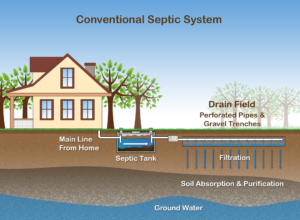Commercial Cleaning Baltimore is the broader term for professional cleaning services within your business. This includes tasks such as trash removal, sanitizing shared equipment and fixtures, cleaning break rooms and kitchens, washing windows, and more.

Your staff is already employed for a certain set of duties, and it doesn’t make sense to ask them to take on additional cleaning responsibilities. Commercial cleaners will come with all the necessary cleaning equipment and supplies to do their job properly.
Floors are often the first thing customers and employees notice in a business. Clean floors give off a professional, welcoming impression, but they also keep people safe. Dirty floors can cause accidents that lead to lost productivity and costly legal action.
Commercial floors come in a variety of materials including concrete, tile, vinyl, and carpet. Each type requires specialized cleaning techniques and supplies for maximum appearance and durability. Regular sweeping and vacuuming, along with occasional deep cleaning sessions, are essential for all commercial flooring types.
Using the right tools for each task makes a huge difference in the quality of a finished product. For example, microfiber mops remove dirt and dust particles without leaving behind lint or residue. A specialized floor cleaner is also necessary for each type of surface. In addition, the use of a scrubber machine helps speed up cleaning time and is especially effective on heavily soiled or waxed surfaces.
Place mats at all entrances to minimize the amount of dirt brought inside. Inspect high-traffic areas for wear and tear, addressing any issues promptly to prevent damage. Schedule a pre-winter deep cleaning session to remove ingrained snow and salt debris. Also, be sure to check carpets for damp spots before running the vacuum cleaner. This will help to avoid water damage to the fibers and prolong the life of the carpet. Providing your cleaning crew with the proper training and tools for their job will ensure that they can effectively maintain your facility’s floors.
Windows
The windows of a commercial setting attract a lot of dust and dirt. In fact, dirt buildup can even cause permanent moisture and damage if left untreated. This is why it’s important to keep up with regular cleaning services. Clean windows allow natural light to enter the space, brightening the atmosphere and providing a more inviting workspace for employees and customers alike.
When it comes to cleaning commercial windows, professionals use a few different methods. First, they sweep away loose dirt and debris. This can be done using a broom, large duster, or even the umpire brush (yes, the one that’s used to sweep home plate at baseball games).
Next, they spray the window with a cleaner. Generally, this is done in a narrow line down the center of the window. However, it’s essential to avoid the edges and non-glass surfaces, since over-spraying can lead to damage. After a brief wait, the professionals will wipe the solution off with a dry, lint-free towel.
Finally, the professional will use a squeegee to eliminate the water from the glass surface. They’ll start at the top corners of the window and work downwards, wiping the squeegee with a clean, dry lint-free cloth in between each pass. This will help prevent the buildup of streaks and spots on the window surface. They’ll also rinse off the squeegee after each use to ensure there are no soap residues left behind.
Walls
Walls, like floors, take a beating in a commercial setting. No matter how much you clean, it’s inevitable that splatters, prints, cobwebs, and residue from food, paper products, equipment and machine parts will accumulate. Kitchen walls, particularly, attract food oil particles that float in the air and land on surfaces, promoting the growth of microbial films and soap scum. It’s important to clean this dirt away using a degreaser.
It’s also important to spot test any cleaning ingredients on an out-of-the-way corner of the wall to ensure that they won’t damage or discolor the surface. To start the cleaning process, dampen a sponge or cloth with your cleaning solution and begin to gently scrub each section of the wall, working from the top down. Be sure to rinse your sponge or cloth often and change the water as needed.
If you have painted walls, it’s a good idea to place old towels, sheets or newspapers on the floor underneath you to protect against any drips. Likewise, if you’re cleaning wallpaper, make sure to put down protective coverings under each section you’re working on.
Many people get frustrated with the streaks that sometimes appear on painted walls. It’s important to note that these streaks are caused by dirt that was already on the walls – when it gets wet, it turns muddy and simply moves around a little bit.
Kitchens
Kitchens in a commercial setting are not only busy and messy, but they also serve as breeding grounds for harmful pathogens. It is thus important to keep these spaces clean to uphold stringent food safety standards and prevent potential health risks.
Commercial kitchen deep cleaning requires thorough sanitizing of all surfaces and appliances, including the stoves, ovens, refrigerators, and dishwashers. It also includes cleaning the floors, cabinets, and drawers, as well as hard-to-reach areas beneath and around equipment. It is important to use a cleaning agent safe for the specific surface and equipment to ensure the best results.
Before starting the cleaning process, it is crucial for cleaners to inspect the kitchen and dispose of any trash. They should also check that there are no loose cords, sharp objects, or slippery spills that could pose tripping hazards. This pre-cleaning preparation will save janitors’ time and energy by ensuring that they are ready for the actual cleaning process.
An extension dusting kit helps janitors reach high shelves and ceiling corners without strain. These kits come with an extension pole attachment and have a variety of different brushes for tackling various surfaces. They can also be used for sweeping and maintaining windows, doors, and appliances. These tools help janitors complete the entire kitchen cleaning task more quickly and efficiently. Moreover, they will be able to prevent the risk of recontamination by not touching areas that they have already cleaned.
Bathrooms
A dirty restroom can send the wrong message about a business, even when other areas of the facility are clean. Hiring a commercial cleaning service with experience in cleaning bathrooms ensures the space is sanitized properly and leaves visitors with a positive impression.
Bathrooms can be a breeding ground for germs and bacteria, so it’s important to thoroughly clean them frequently. This includes scrubbing and disinfecting toilets, sinks, counters, urinals, and mirrors. It also involves wiping down door handles and light switches with antibacterial wipes to reduce spread of illness. Keeping supplies like toilet paper, hand soap, and paper towels stocked, as well as regularly restocking trash cans, helps to keep the restrooms clean and functioning.
During the cleaning process, janitors should start with toilets and urinals to prevent them from becoming overflowing. They should then sweep and scrub the floors, using a disinfectant cleaner. Next, they should disinfect the sink area by spraying a solution on counters and faucets to kill germs. Finally, they should wipe surfaces and mirrors with a dry rag to remove smudges and streaks.
Depending on the cleaning company, they may also wipe and disinfect trash cans by sanitizing inside and out with cleaner, spraying a deodorizer in the interior to eliminate unpleasant smells, and washing the exterior of the bin. They should empty and rinse the garbage cans frequently to avoid overflowing, as well as restock with fresh liners when needed.
Upholstery
Your commercial furniture is more than just decor; it is a staple in your company’s professional image and a key component to employee comfort. It also plays a vital role in preserving a clean, hygienic environment for employees and customers. Regularly cleaning your upholstered furniture will help protect your investment at a fraction of the cost of replacing it.
The best way to ensure that your upholstered furniture is cleaned correctly is to hire professional cleaners who understand the various fabric types and their needs. They can use a variety of methods to get your upholstered furniture looking and smelling new again, from steam cleaning to hand-washing.
To avoid damaging your furniture, always test any cleaning solution on a small area of the upholstery before using it. If you notice any discoloration or damage, immediately discontinue use of the cleaning product and contact a professional.
Create a regular schedule to vacuum and spot clean your upholstered furniture on a daily basis. This will prevent the buildup of dirt and dust on the furniture. In addition to regular cleaning, you can protect your upholstered furniture by applying a fabric protector that prevents spills and staining. The protection can be applied by a professional or purchased from your furniture dealer. Be sure to follow the manufacturer’s guidelines for application of the product. Always allow your upholstered furniture to dry completely after cleaning. This will help prevent moisture build-up and mildew.
